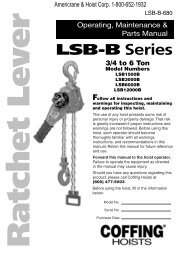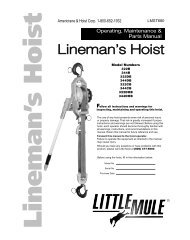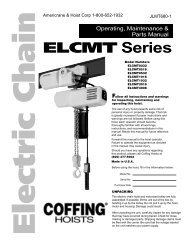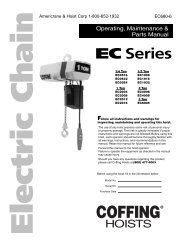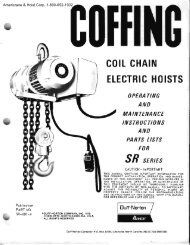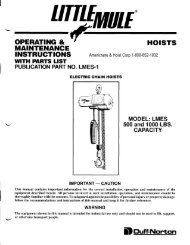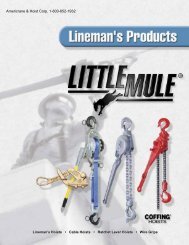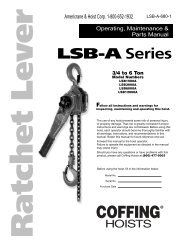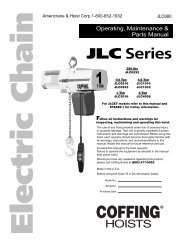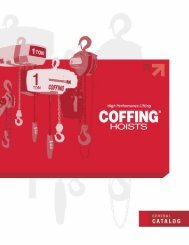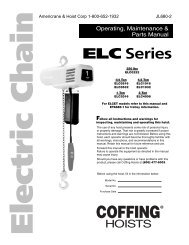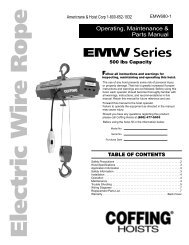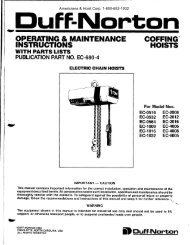MA Series part 1 - Coffing Hoists, Coffing Hoist Parts
MA Series part 1 - Coffing Hoists, Coffing Hoist Parts
MA Series part 1 - Coffing Hoists, Coffing Hoist Parts
- No tags were found...
You also want an ePaper? Increase the reach of your titles
YUMPU automatically turns print PDFs into web optimized ePapers that Google loves.
2_1. INSPECTION PRIOR TO INITIAL USE.2-2. Any new or repaired hoist, as well as the workingarea, shall be carefully inspected prior to initialinstallation and use. The inspection shall be made byor under the direction of a person familiar with hoistoperations and industrial safety standards.2-3. The following inspection criteria are recommendedprior to initial installation and use. Additionalinspection items should be added to satisfy localusage and safety requirements. All inspections of anykind should be logged or recorded, dated, signed andfiled for reference purposes.a. Ensure that the supporting structures arestrong enough to carry the intended loads. The supportingstructure shall have a safe load rating at leastequal to that of the hoist. The supporting structuremust be rigid and not subject to weakening due torepeated stresses from the hoistb. Ensure that there is adequate working spaceto permit hoist operation. Normal operation should notrequire pulling or tugging around corners or obstructions.Also, there must be adequate space to permitthe operator and other persons to stand clear of theload and adjacent structures.sEcTroN tlPREPARATION FOR USEc. Watch out for makeshift or compromisingpractices either during installation or subsequentoperation of the hoist. Sometimes the "temporary" fixremains until an accident occurs.d. Perform both the frequent and the periodicinspections specified herein on a repaired hoist priorto initial use. Perform the frequent inspections specifiedherein on a new hoist prior to initial use.2-4. INSTALLATION.2-5. Secure the hoist to a suitable supporting memberby use of the top hook. Make sure that the hook latchis closed. Apply a small amount of lubriplate or equivalentbetween the hook and supporting member.2-6. TESTING.2-7. Check the hoist through a few lifting and loweringcycles with no load o4 the hook. Attach a loadof fifty pounds to the hook and check the hoist througha few lifting and lowering cycles. Check for loaddrift. If brake operation is normal with this light load,test the hoist for operation with the rated load, andthen with about 125 percent ol the rated load. Thehoist should operate smoothly and the brake shouldprevent load drift.Americrane & <strong>Hoist</strong> Corp 1-800-652-1932sEcTloN lllOPERATION3-1. SAFETY CONSIDERATIONS.3-2. This hoist is designed for proper operationwithin the limits of its rated capacity. The hoist hasfeatures designed to minimize the potential for injurydue to failure of the hoist itself. However, here aresome additional pointers which should be followed inorder to ensure proper operation.a. Do not overload the hoist.b. Do not use a handle extender (cheater bar).The hoist is designed to lift or pull its rated capacitywhen a reasonable effort is applied to the end of thehandle by one person (see table I). If effort appears tobe excessive recheck the load and use a larger capacityhoist if necessary.c. Do not side load the hoist. Always pull in astraight line between hooks. Side loading over a sharpcorner may fracture the hoist housing or load block.d. Be sure there are no twists in the loadchain.e. Do not operate the hoist from an off balanceposition. Operator should have firm footing or beotherwise secured before operating the hoist.f. Before raising or pulling a load, alwayscheck to see that it is held securely in the hook orsling, etc. Raise or pull the load only until the loadchain is taut and then recheck the rigging beforecontinuing to raise the load.g. Make sure that the slings and other rigginghave sufficient capacity to support the load, and arein good condition.h. STAND CLEAR OF THE LOAD AT ALLTIMES. Do not move a load in such a manner as toendanger personnel.i. Do not leave the hoist under load for extendedor unattended periods unless specific precautionshave been taken to provide protection.j. Do not wrap the load chain around a load.Use a SLING!k. Do not TIP-LOAD any hook, as this willexert undue strain in the hook, resulting in hookfailure.l. The <strong>MA</strong> series of hoists are designed formanual operation by one person. Do not attempt tooperate hoist with other than the manual power furnishedby one person.m. DO NOT USE THE HOIST TO LIFT, SUP-PORT OR OTHERWISE TRANSPORT HU<strong>MA</strong>NS.3-3. OPERATION. (See figure 3-1.)3-4. The hoist should be operated by qualified



